Henri-Paul Motte (13 December 1846 – 1 April 1922) was a 19th-century French painter from Paris, who specialised in history painting and historical genre. Motte was a pupil of Jean-Léon Gérôme and began to exhibit at the Paris Salon from 1874 onwards. -Henri-Paul Motte - 12 artworks - painting
There is very little information about French artist Henri-Paul Motte (1846 – 1922) online. Motte studied under Jean-Léon Gérôme and was a regular exhibitor at the Paris Salon.
I love his work, and I consider it very curious and interesting. However when I point it out to some of the younger folk today they just shrug their shoulders and say that Instagram has better photos, and that painting and art is too “rigid” and not suitable for their tastes.
They explain that representative art is just an old style of photography from before the time of the invention of the camera. Since the camera is “better” at recording images, that art need not be true to form, but can be free-form and shapeless.
I disagree.
I guess that I am just an old codger. I guess.
Here’s some great examples of Motte’s work. To fully appreciate what is going on, you do need a few short history lessons. But, it’s all fun and very interesting. I’ll tell you what.
The Fiancée of Belus
I’ve always loved this painting. It’s rather fantastic, and unlikely to be historically accurate, but never the less, it’s beautiful.
For the Tyrian king in Roman mythology, see Belus (Tyrian). Belus was the son of Poseidon and Libya; a descendant of the river god Inachus and nymph Melia. His brother was King Agenor of Phoenicia and he was married to Achiroe, the daughter of the river god Chremetes. Achiroe's sister Telephassa, was married to Agenor. -Belus | Mythology wiki
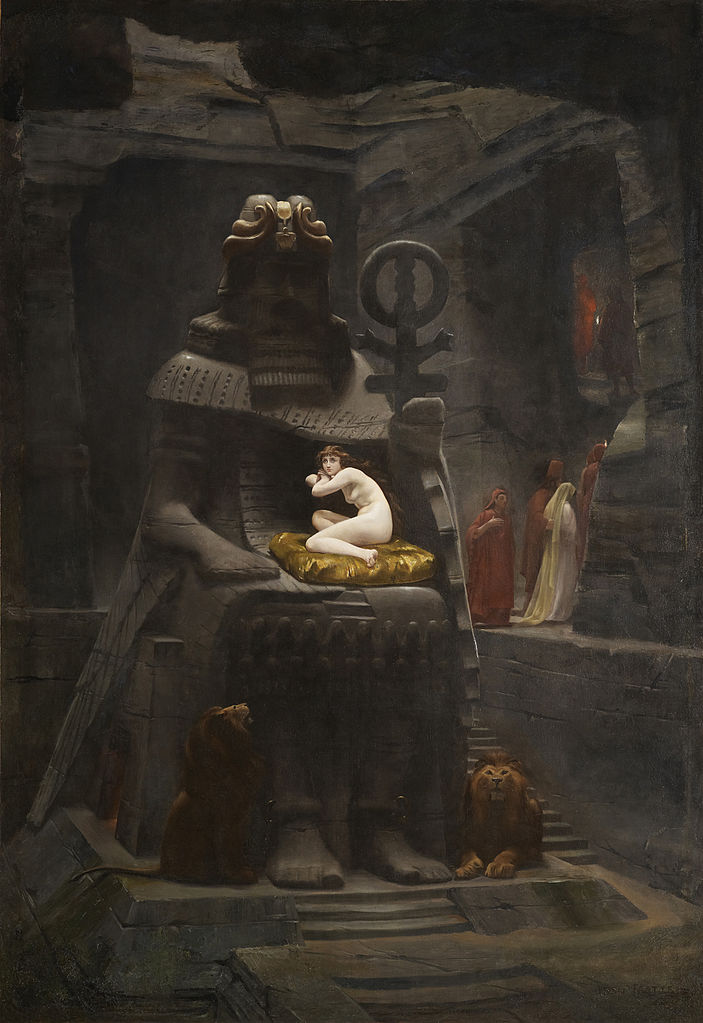
Cardinal Richelieu at the Siege of La Rochelle
The painting is concerned with a major player of the “Thirty Years War”.
Armand Jean du Plessis de Richelieu, Cardinal-Duc de Richelieu (September 9, 1585 – December 4, 1642), was a French clergyman, noble, and statesman. He was consecrated as a bishop in 1607, he later entered politics, becoming a Secretary of State in 1616. Richelieu soon rose in both the Church and the state, becoming a cardinal in 1622, and King Louis XIII's chief minister in 1624. He remained in office until his death in 1642; he was succeeded by Jules Cardinal Mazarin. The Cardinal de Richelieu was often known by the title of the King's "Chief Minister." He sought to consolidate royal power and crush domestic factions. By restraining the power of the nobility, he transformed France into a strong, centralized state. His chief foreign policy objective was to check the power of the Austro-Spanish Habsburg dynasty. Although he was a Roman Catholic cardinal, he did not hesitate to make alliances with Protestant rulers in attempting to achieve this goal. His tenure was marked by the Thirty Years' War that engulfed Europe. -Cardinal Richelieu - New World Encyclopedia
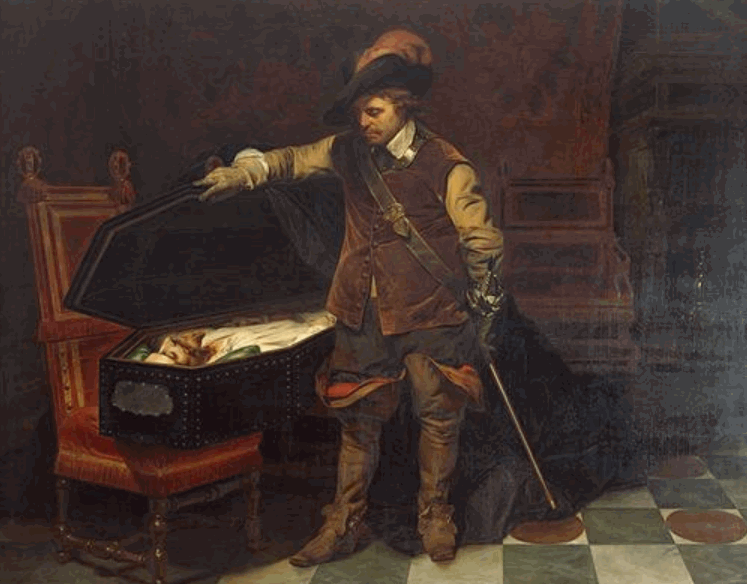
Druids Cutting the Mistletoe on the Sixth Day of the Moon
Who were the Druids?
Well, when Roman armies set about the conquest of Iron Age Britain in AD 43, they later attacked Anglesey under the command of Suetonius Paullinus. The Romans’ Celtic enemies appeared at the shore, among them women in black with torches aflame, resembling mythical Furies.
Suetonius – ultimately victorious – took care to demolish his opponents’ sacred altars, which were stained with the blood of sacrificed humans.
The ones apparently responsible for this were the Druids, the educated ‘upper’ class who supposedly officiated as magician-priests, even lawmakers, and who shielded the mysteries of Celtic religious beliefs.
Julius Caesar – in his Gallic Wars – also mentions human sacrifice among the Celtic upper echelons, with their victims immolated in a huge pyre. (The inspiration for the 1973 pagan horror movie, The Wicker Man.)
Ancient historian Diodorus Siculus mentioned that one of the Druids’ methods of divining the future was to stab a man in the chest, then observe how he moved in his death throes. So could these elite, educated men also be the barbarians committing human sacrifice?
For that matter, how much do we really know about the Druids, anyway?
Some authorities say we know next to nothing, and not even the accounts of ancient historians are to be relied upon. One of them is Professor Ronald Hutton – and I agree (the reasons are given below.)
As the Daily Telegraph once reported:
‘In 1984, peat-cutters at Lindow Moss in Cheshire found a well-preserved body which was eventually dated to the first century AD. ‘Lindow Man’ … appeared to have undergone a ritual killing, and his stomach contents included grains of mistletoe pollen. Proof at last, it was said, that the Greeks and Romans were right: Druidic sacrifice was a grisly business, involving both mistletoe and blood. But when Ronald Hutton discusses this evidence, he shows that not a single detail can be relied on. The pollen consisted of four grains – a literally microscopic quantity, which might have just blown on to the man’s lunch. What looked like garroting might have been just the effects of a corroded necklace, and the gash to the man’s jugular could have been caused by peat-cutting equipment. As for the Greek and Roman authors, few had any first-hand knowledge of Druids in either Gaul or Britain; and the one who was best placed to gain it, Julius Caesar, seems to have copied his information about Druids out of somebody else’s writings instead.’
Despite (or because) of our lack of inner knowledge of the Druids, they have fascinated commentators for generations. This is especially true for modern neo-pagans, drawn to their veneer of secrecy and their mystique as guardians of unfathomable, arcane wisdom.
But there are no texts recording their own beliefs, no contemporary origin stories, as with Christianity – there is no ancient Celtic Bible!
Accordingly, the word ‘Druid’ is not Celtic but a conflation of the Greek word drus (oak tree or oak wood) and the Indo-European infinitive wid (‘to know’). Thus, a Druid is, metaphorically, ‘one who knows the oak’.
Oak trees have a special totemic power and sanctity in Celtic tradition.
It was the Druids’ task to interpret the handiwork of the gods in all its forms, and with its long age and great size, the oak represents everything that speaks of life, that has strength, that endures, that appears immortal, even.
The Druids and the Mistletoe
This brings us to that fabled object of ritual desire, the mistletoe. In fact, we’re about to open the door to a treasure trove of magical symbolism. Here is what the Roman historian Pliny (c. AD 77) had to say about the Druids:
‘The Druids—for that is the name they give to their magicians held nothing more sacred than the mistletoe and the tree that bears it, supposing always that tree to be the robur [Latin for oak]… In fact, it is the notion with them that everything that grows on it has been sent immediately from heaven, and that the mistletoe upon it is a proof that the tree has been selected by God himself as an object of his especial favor. The mistletoe, however, is but rarely found upon the robur; and when found, is gathered with rites replete with religious awe … Having made due preparation for the sacrifice and a banquet beneath the trees, they bring thither two white bulls, the horns of which are bound then for, the first time. Clad in a white robe the priest ascends the tree, and cuts the mistletoe with a golden sickle, which is received by others in a white cloak. They then immolate the victims … It is the belief with them that the mistletoe, taken in drink, will impart fecundity to all animals that are barren, and that it is an antidote for all poisons.’
We’ll soon see how fanciful this is, but apparently, in the ancient Druid tongue, the word for mistletoe translated as ‘all-healing’, and the parasite mistletoe is indeed said to be used in early medicine. (Even in the 20th century it was thought to be able to cure epilepsy.)
And yet, the plant is also known to be toxic, and one wonders how safely it was used.
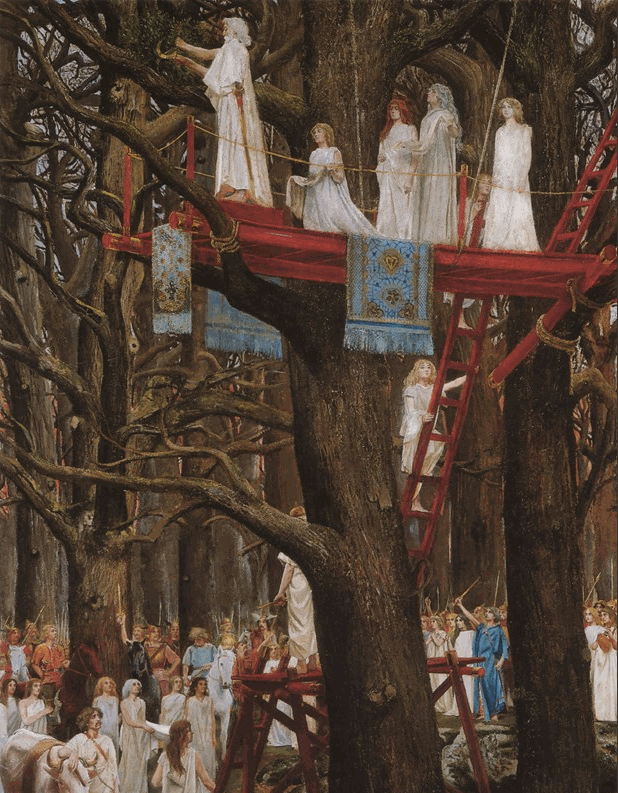
The Geese of the Capital
Rome is often viewed in a few set periods. The Fledgling founding by Romulus, the Punic Wars, the Civil wars and Empire, and finally the fall. Once Rome grew to cover most of Italy they it exploded into the Mediterranean, scooping up new territory with almost every war, but the struggle for Italy was a long and taxing period for Rome.
They fought many fierce enemies near and far and in wars lasting generations. The great siege of Veii was a monumental undertaking of a strong rival city only ten miles away, and that took approximately ten years to complete.
When hordes of Celts came rampaging through Italy, the Romans were simply not prepared for the new and fearsome enemies from outside their familiar Italy.
The Celtic expansions of the 6th-3rd centuries BCE caused a lot of early commotion throughout Europe. It would bring about the growth of a Celtiberian realm in Spain, and the Celts traveled so far that they formed their own state in the middle of modern Turkey. A group of Celts known as the Senone was led through Italy by their commander, Brennus.
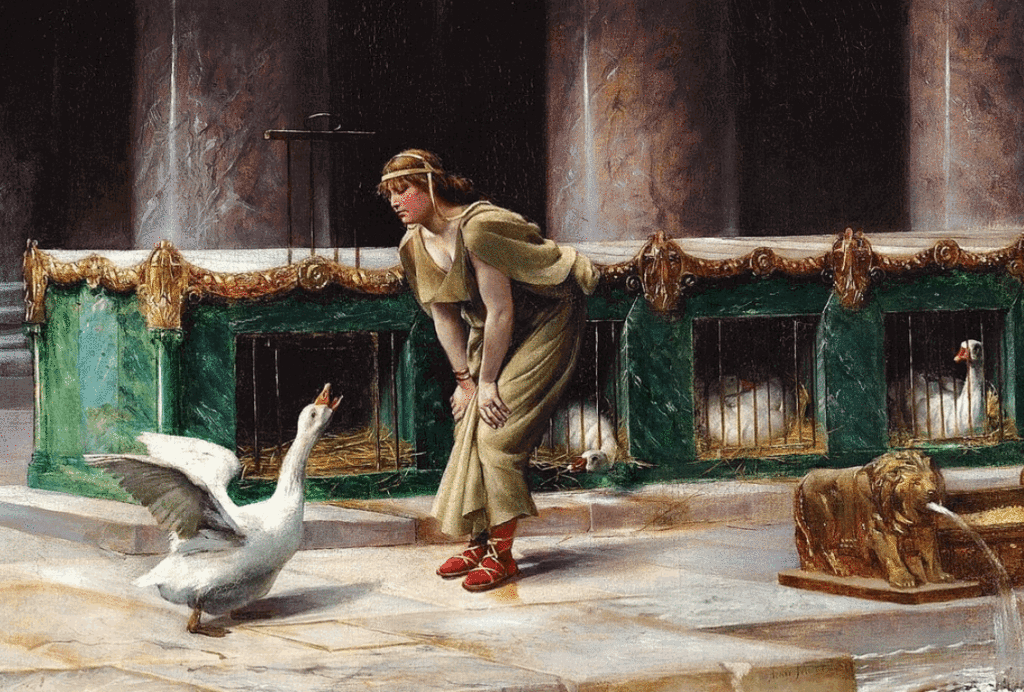
The Senone Gauls were threatening the nearby town of Clusium, when Roman Ambassadors from the Fabii family were sent to negotiate peace for Clusium. The Romans were notoriously aggressive, and so it is only a little surprising that when a scuffle broke out between the Gauls and Clusians, the Fabii joined in and actually killed a Senone chieftain.
The Roman people voted to decide the fate of those who broke the sacred conduct of ambassadors, but the Fabii were so popular that they were instead voted to some of the highest positions in Rome. This absolutely infuriated Brennus and his people and they abandoned everything and headed straight for Rome.
Rome was woefully unprepared for this sudden attack.
The Gauls had marched with purpose, declaring to all the towns they passed that they would not harm them, they were heading straight for Rome. The numbers are heavily disputed for this battle with figures ranging from 9,000 to 40,0000 for either side. It seems likely that each side had about 12-15,000 men, but the Gauls had hardened veterans and the Romans mostly raw recruits. The Romans had also earlier exiled a celebrated commander Camillus on corruption charges.

The battle for the defense of Rome was fought near the Tiber and Allia rivers. The Gauls seemed to have a slight numbers advantage and the Romans, under command of one or a group of Tribunes, decided to put a reserve force on a nearby hill. The hope was to counter-flank the Gauls if the broke through the Roman center or enveloped the wings.
Brennus saw through this and decided to send a force straight at the Roman hilltop reserves.
The surprised Romans soon fled. The rest of the battle was an utter disaster for the Romans, likely fearing this new and significantly larger enemy. Many Romans scattered to the recently conquered Veii and many others went to Rome. Many drowned trying to cross the river while still wearing armor.
The Gauls were astonished by how easy their victory was.
Rome only had control of a few dozen miles around their city but had built up a powerful reputation throughout Italy. It took only a day for the Gauls to reach Rome, and again they were surprised by how lightly defended it seemed to be.
The light defense was due to the sheer panic following the battle, only a small portion of the survivors were able to make it back to Rome. People fled to nearby cities or the country, many of the priests and priestesses took their religious artifacts out of the city. Those who stayed mostly fortified the steep Capitoline Hill, though some of the nobles and elderly decided to defend their homes.
When the Gauls stormed the walls they killed these lingering men and rampaged through the city. They soon realized that the bulk of the remaining inhabitants were entrenched in the tall Capitoline hill and promptly attacked, full of confidence from their earlier victories. For the first time, the Romans effectively fought back, easily holding the high ground.
The assault a disaster, Brennus decided to simply lay siege to the hill and sent his men out to forage supplies.
Here they came to blows with the exiled Camillus, who organized a resistance from a nearby town. Back in Veii the disgraced Roman survivors fought back against some Etruscan Raiders hoping to take advantage of the defeat. The Romans in Veii marshaled under the command of Quintus Caedicius, a respected Centurion.
Caedicius saw that hope rested with Camillus commanding the counter attack.
It is from here on that some truly unbelievable, almost humorous events ensued. To get permission for the exiled Camillus to lead, Caedicius had to get approval from the senate on the besieged Capitoline. A messenger snuck through the Gallic camp and scaled the unguarded cliff side of the hill to deliver the message. It was quickly decided to restore Camillus to his command and to give him dictatorial powers and then the messenger snuck his way out again.
Though official word was received the attempt greatly risked the lives of all who resided on the Capitoline for the Senone scouts discovered the messenger’s footprints and figured out that there was a way to scale the cliffs. They choose a night with a full moon and sent their bravest warriors up the cliff. The ascent was so skillful that neither the Roman sentries nor their dogs noticed anything, but the Geese did.
The Geese were actually a sacred animal of Juno, kept and fed on the Capitoline despite the dwindling food. they began quacking and honking relentlessly and some of the sleeping Romans were awakened. The first to respond was a man named Manlius.
Manlius did not hesitate for a second and charged the few Gauls cresting the top of the cliff. He killed one and pushed another off the cliff with his shield.
Soon other Romans joined the fight and killed the remaining Gauls as they came up. Other Gauls still clinging to the rocks had little hope of survival as the Romans threw javelins and rocks at them until they fell to their death.
After this battle the Gauls themselves suffered some disease and food shortages, as they laid siege to the Romans. With both sides in a difficult position, negotiations were made to pay the Gauls to leave. As the humiliated Romans loaded gold onto the scales they noticed that the Gauls were rigging the weights to make the Romans pay more than agreed.
Brennus calmly threw his sword on with the Gallic weights and said the famous words “Vae victis” meaning “woe to the vanquished/conquered”, words that the Romans would take to heart. Successive generations would fight with great ferocity in order to never hear those words again.
“Vae victis” meaning “woe to the vanquished/conquered”
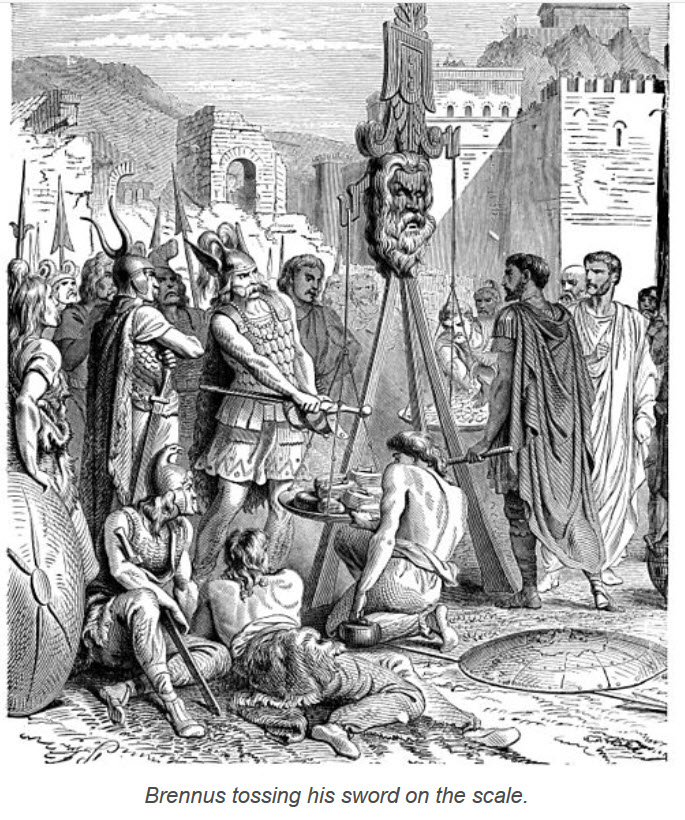
The sources are unclear, but it seems that before the transaction of gold was actually complete the Dictator Camillus appeared on the scene. As dictator, he declared the gold deal void and demanded that the Gauls leave immediately. Camillus told the Romans that they would win back their city through steel, not by gold.
The Gauls were furious by the retraction of the gold that they were so close to acquiring and marched out to attack Camillus’ newly formed army comprised of the survivors of the earlier battle at Allia and many new volunteers. The Romans under the skilled command of Camillus won an easy victory and attacked the retreating Gauls and completely sacked their camp and killed almost every Gaul.
The sources for this story are often not in agreement were written generations after the events. The Geese are a common theme and their saving of the Capitoline is just crazy enough to be plausible. Camillus’ timely intervention and complete defeat of Brennus’ army may have been added to make for a less humiliating story, though other humiliating aspects are left in the accounts.
The ambassadors flagrantly disregarding the peaceful role and killing Gauls is certainly embarrassing, despite how the men themselves were viewed by their fellow Romans.
The initial Roman defeat is never put in any sort of good light, it was a humiliating loss and represented that way. So the story could have occurred as written above through primarily Livy as a source. Other sources have the Gauls leaving with the gold and being defeated at a later date, but what we do know is that Rome was very nearly completely captured by a foreign foe, and miraculously saved by some spooked geese.
By William McLaughlin for War History Online All credit due to William in this great write up.
Seige of La Rachelle
The siege of the Huguenot stronghold of La Rochelle by the forces of Louis XIII, 1627-9, was a huge operation that lasted for fifteen months. The king’s forces had to devise massive seaward barriers to prevent the English, who had occupied the fle de Re, from assisting their Huguenot allies. Three-quarters of the population died from starvation. -Siege of La Rochelle | Weapons and Warfare
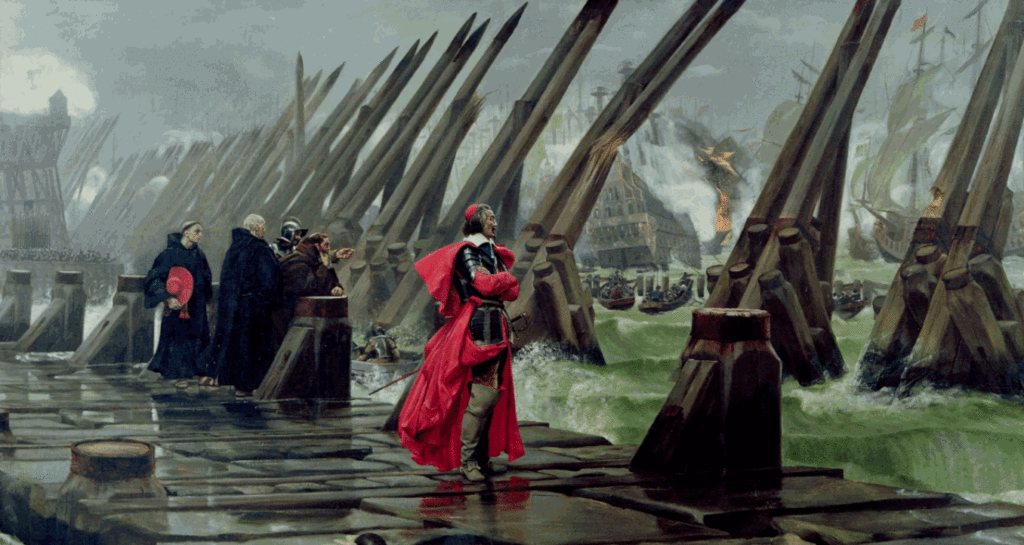
Hannibals crossing of the Rhone
At the beginning of the treacherous passage, Hannibal entered Gaul with 50,000 infantry and 9,000 cavalry. He then crossed the Rhone river with 38,000 infantry and 8,000 cavalry. After crossing the Alps, Hannibal controlled 12,000 African and 8,000 Spanish infantry. -Why did Hannibal cross the Alps ? | History Forum
Hannibal’s plan of persuading the Roman allies to join him required him to take the Second Punic War to Italy.
In order to do so, he had huge obstacles to overcome.
The feat alone of transporting an entire army of men and elephants to Italy is evidence of Hannibal’s military aptitude.
The first of these great obstacles came at the 800 yard wide Rhone River. To add to the difficulty of crossing such a body of water, the Volcae people, natives of the Rhone River, wished to stop him. They gathered all of their boats and moved to the far side of the river, intending to use it as a barrier and fight Hannibal while he was vulnerable in crossing.
The traditional military strategies of the time would have Hannibal to attempt to find another place to cross the river. Fortunately, Hannibal did not believe in following the traditional approach anymore than Caesar did. He came up with a new way to cross and thus once again proved himself to be a great innovator.
When he reached the river, Hannibal gathered what few boats he could find from the inhabitants who stayed in their homes.
The Gauls aided him by hollowing out the trunks of trees to make canoes and then taught his Spanish soldiers how to do so. The problem of how to cross sorted, Hannibal had to find a way to cross without being destroyed by the Volcae.
An army trying to cross a river cannot fight back, particularly when its enemy has arrows.
Hannibal selected Hanno from among his officers to lead a division of Spaniards and Gaul guides upriver to cross out of sight of the enemy.
After a day of marching, Hanno and his company found a shallow part of the river and easily crossed—many of the Spaniards swam with their shields on their backs while the others quickly made rafts for the horses. They proceeded to march uphill behind the Volcae and lit a fire.
When Hannibal saw the smoke of Hanno’s fire, he ordered his men to begin crossing the river.
The Volcae were so focused on Hannibal’s army crossing that they did not know Hanno approached from behind. Hanno easily took their camp as they started to fight Hannibal. When the Volcae became aware of the ambush, they realized they were surrounded and fled.
Hannibal specialized in preparing for battles, setting the field up so he could surround or ambush superior forces. Few would have thought to send a small group of men on a three day detour to fight a force on the other side of the river, yet a head-on attack would surely have spelled doom for Hannibal.
The surrounding of the Volcae was not Hannibal’s only innovation at the Rhone, however. He was also very creative in how he actually crossed the river. He had a long line of boats moored upstream completely covering the width of the river so that the lighter vessels could be rowed on the side sheltered from the wind and current (Dodge 181). This enabled his men, largely inexperienced at sailing, to cross calm water easily. Most of his horses swam but several were taken over barges fully tacked up so they would be ready for battle on the moment of crossing.
The elephants proved to be the greatest challenge for crossing the Rhone.
As Hannibal’s elephants were bred in captivity, they never learned to swim, making it difficult to convince them to cross a river.
Two theories are held about how he got the elephants across. The first, and most simple, follows the principle of herd mentality. The driver of the dominant female elephant teased her until she chased him into the river. The rest of the elephants, as herd animals, then followed her into the river and across.
The second, longer theory, if true, demonstrates more great innovations of Hannibal. He had two 200’X50’ rafts made and covered with dirt so they looked like ground. The first raft was moored to the side and would not move while the second lay loose just beyond. The elephants were coaxed onto the first, then second raft and on that moved to the other side. According to Livy, who is the source of this theory, many got scared and jumped off the rafts and swam the rest of the way ashore.
Both theories are evidence of the original thinking of Hannibal and his ability to overcome all adversities.
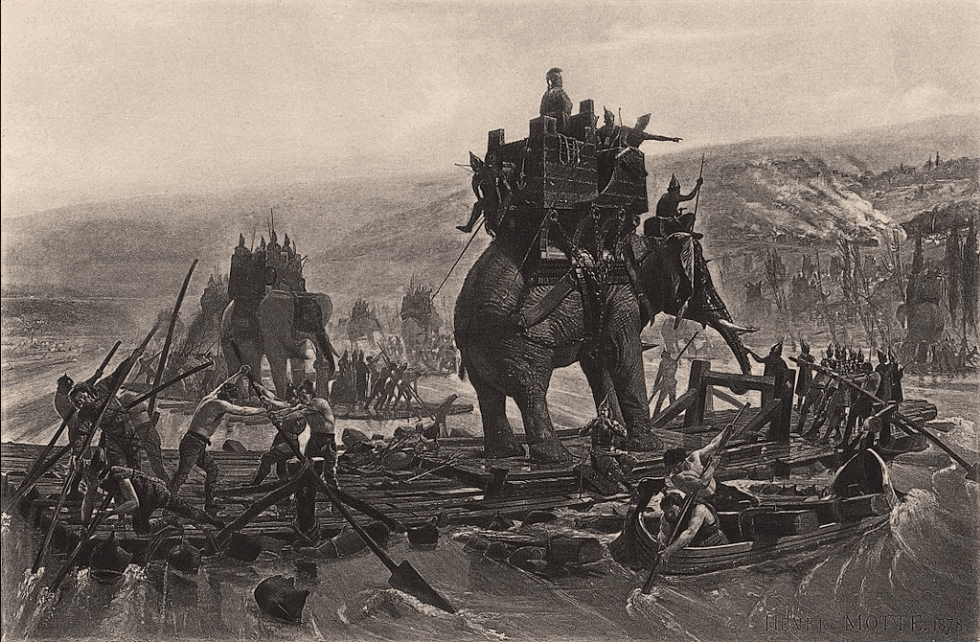
The Trojan Horse
The Trojan Horse is a story from the Trojan War about the subterfuge that the Greeks used to enter the independent city of Troy and win the war. In the canonical version, after a fruitless 10-year siege, the Greeks constructed a huge wooden horse and hid a select force of men inside, including Odysseus. The Greeks pretended to sail away, and the Trojans pulled the horse into their city as a victory trophy. That night the Greek force crept out of the horse and opened the gates for the rest of the Greek army, which had sailed back under cover of night. The Greeks entered and destroyed the city of Troy, ending the war. -Wikipedia
Trojan horse, huge hollow wooden horse constructed by the Greeks to gain entrance into Troy during the Trojan War. The horse was built by Epeius, a master carpenter and pugilist.
The Greeks, pretending to desert the war, sailed to the nearby island of Tenedos, leaving behind Sinon, who persuaded the Trojans that the horse was an offering to Athena (goddess of war) that would make Troy impregnable.
Despite the warnings of Laocoön and Cassandra, the horse was taken inside the city gates.
That night Greek warriors emerged from it and opened the gates to let in the returned Greek army.
The story is told at length in Book II of the Aeneid and is touched upon in the Odyssey.
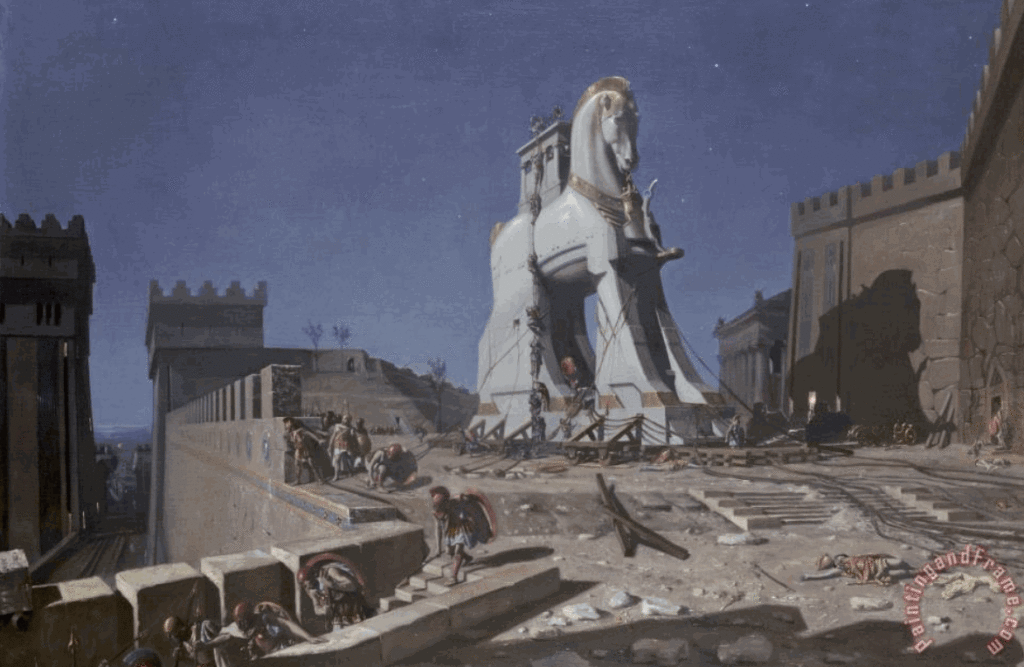
The Mirage
Mirage An optical illusion caused by atmospheric conditions, especially the appearance of a sheet of water in a desert or on a hot road caused by the refraction of light from the sky by heated air.
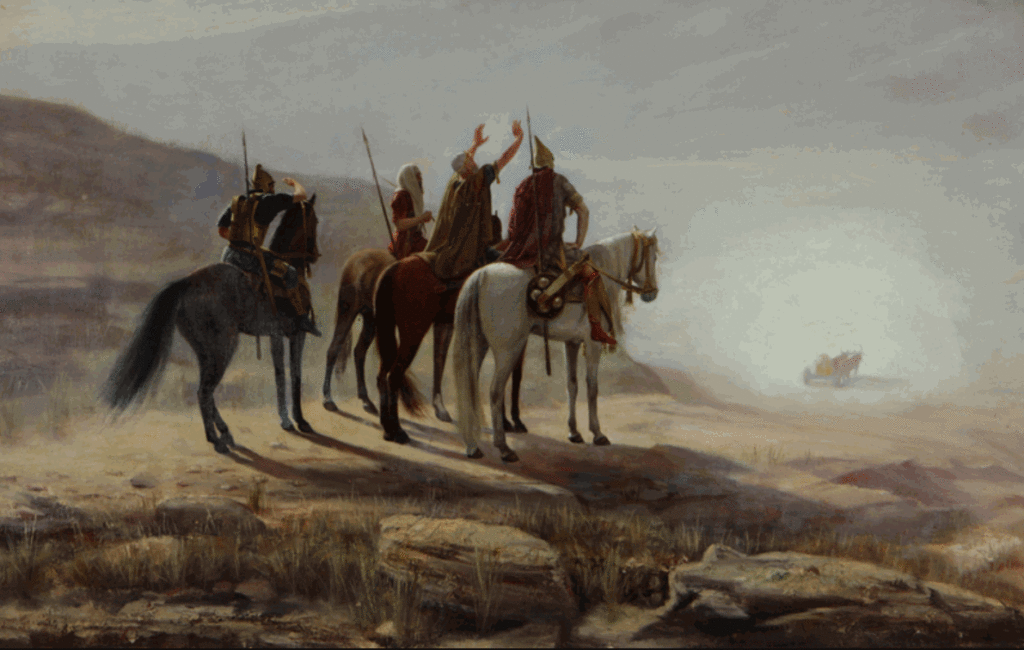
Vercingetorix Before Caesar
The Gallic chief Vercingetorix (72-46 BC) surrendering to the Roman chief Julius Caesar (100-44 BC) after the battle of Alesia in 52 BC. Painting by Henri Motte (1846-1922) 1886. Crozatier Museum, Le Puy en Velay, France.
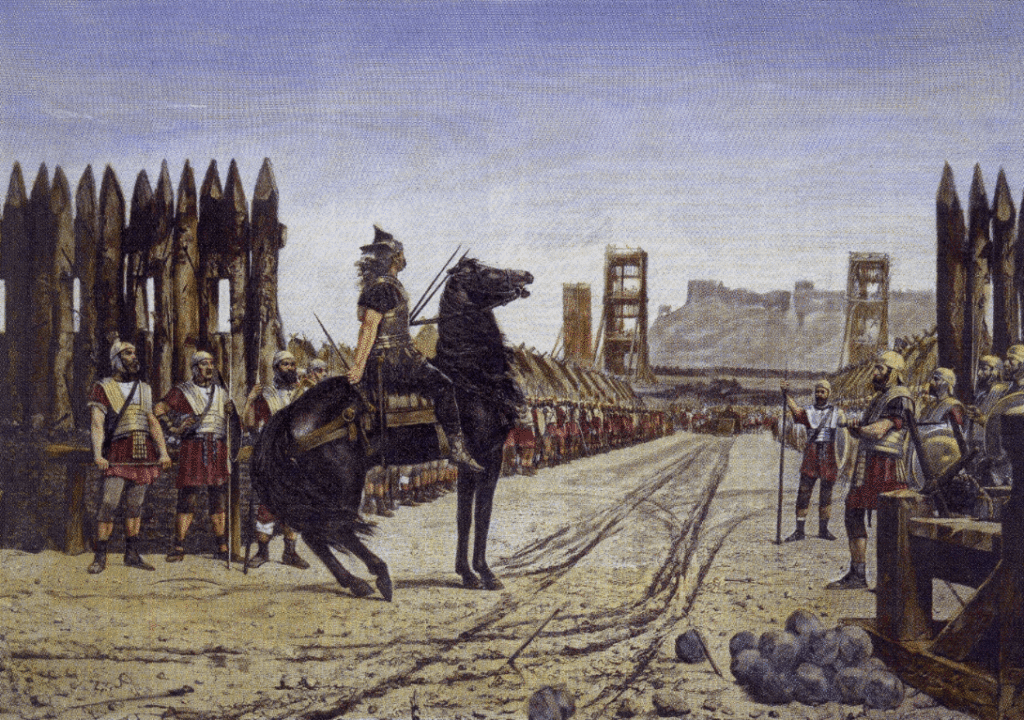
César s’ennuie
He we look at Caesar, bored, looking at the caged captives. As he decides on what to do with them.
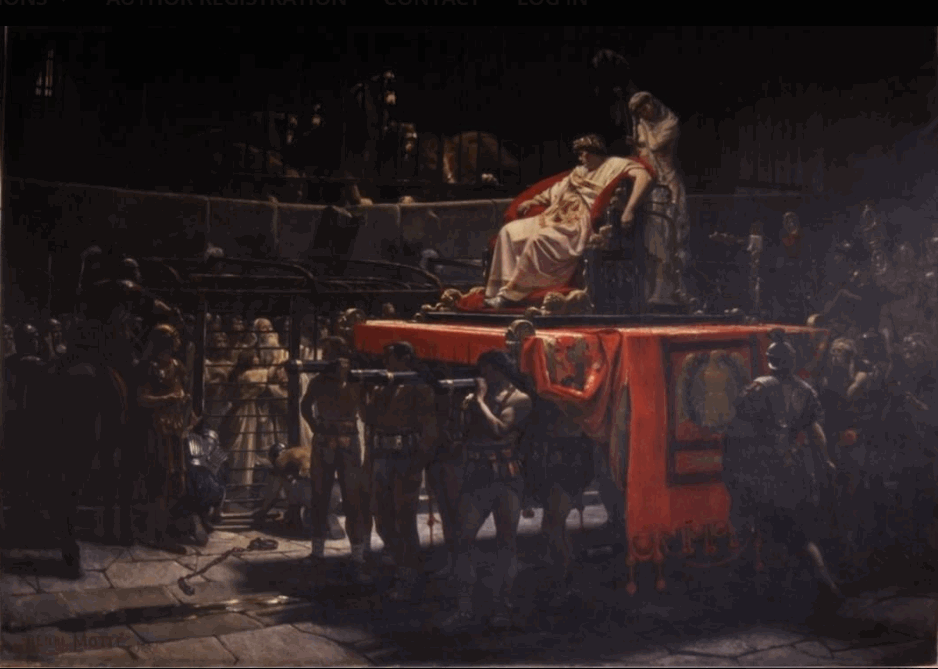
Napoleon in Front of the Throne
In 1799, Napoleon Bonaparte, a general in the army, was named first consul of the French Republic. But Napoleon’s ambitions were too large for the role. At the end of 1804, he crowned himself Emperor of the French in an elaborate, highly planned ceremony. By that time, he had brought much of continental Europe under French control.
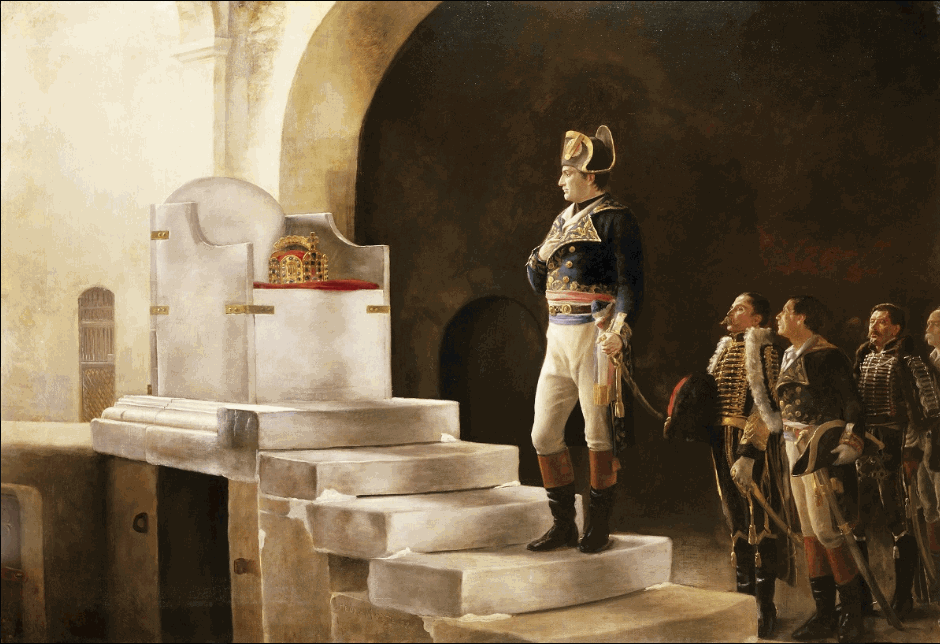
Junos Geese Save the Capitol
Another painting that aptly describes how the geese saved Rome.
All that we have of this image is a blurry black and white photograph of it. As the original, I believe, has long been destroyed and is now obliterated from viewing.
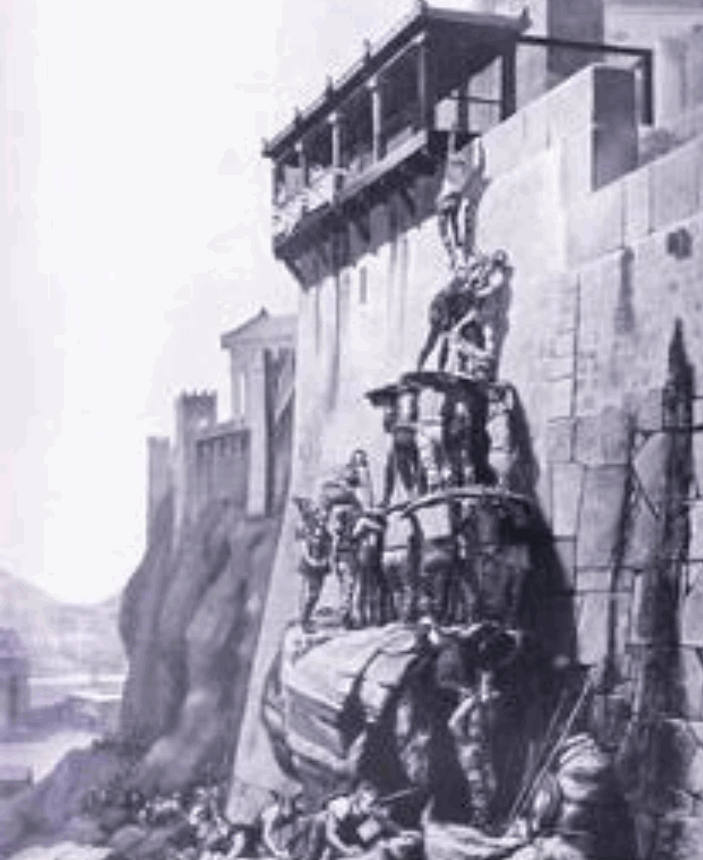
Die Gartenlaube (the Garden Arbor)
I’m not quite sure what this painting represents. But in full color and in it’s magnificent size, it must have been spectacular. I am sure that it resided over a mantle within one of the great homes in Europe.
Unfortunately all that remains of this work is this black and white poor photograph of it. We can well imagine that it was destroyed during one of the great wars of Europe. And all we can have is the pale copy of a blurry photograph.
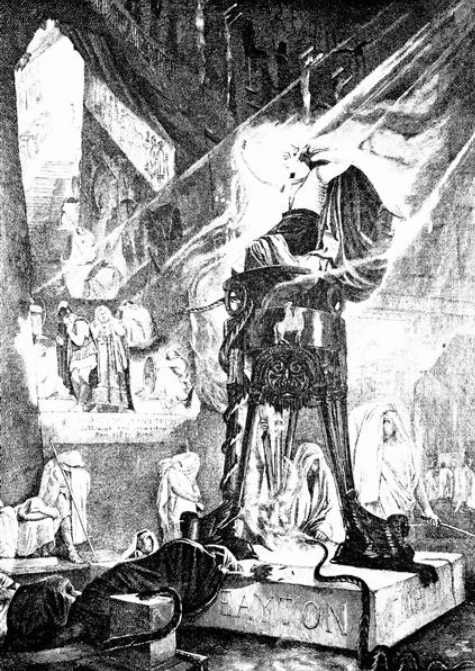
Die Gartenlaube
This work of art is probably a black and white photograph of a work that has become lost, misplaced, or damaged over the years. We should consider ourselves fortunate to have the photograph, even though the original would have been magnificently colorful.
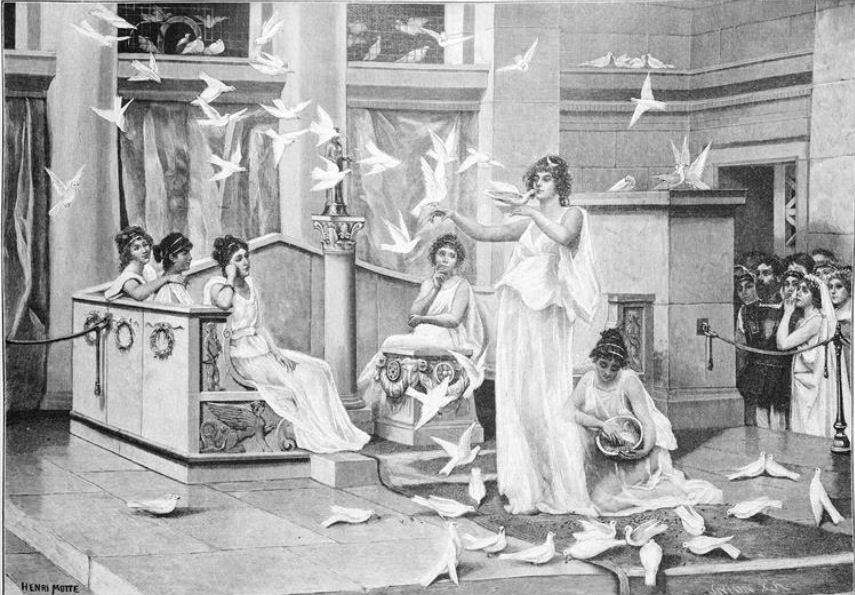
Do you want more?
I have more posts in my Art Index here…
ARTArticles & Links
You’ll not find any big banners or popups here talking about cookies and privacy notices. There are no ads on this site (aside from the hosting ads – a necessary evil). Functionally and fundamentally, I just don’t make money off of this blog. It is NOT monetized. Finally, I don’t track you because I just don’t care to.
To go to the MAIN Index;
Master Index.
- You can start reading the articles by going HERE.
- You can visit the Index Page HERE to explore by article subject.
- You can also ask the author some questions. You can go HERE .
- You can find out more about the author HERE.
- If you have concerns or complaints, you can go HERE.
- If you want to make a donation, you can go HERE.
Please kindly help me out in this effort. There is a lot of effort that goes into this disclosure. I could use all the financial support that anyone could provide. Thank you very much.



Another set of great history pieces. Well done!